I am separating the fencing study into four parts in order to clarify these stages.
#PhilosophicalFriday
It is said in western sport fencing that “It’s all in the wrist”. With Tai Chi sword work “It’s all in the centre”.
Do we use force? – We do.
What force? – Mostly Yin, some Yang.
A general way of measuring sword length is with the pommel on the floor, the point reaching near but not higher than your navel. However since the length of the blade is the most important element, and …
In all of these works the swords were shown to require great skill in their use, as well as noble and spiritual qualities,…
This sometimes happens while doing forms, in dreams, while reading the Classics or viewing films of the master…
All serious students of Tai Chi read this material repeatedly; as they progress they become more able to grasp formerly obscure concepts.
Tai Chi Sword – An Instrument of the TAO
Kenneth Van Sickle leads the reader through the various attributes of this, the most gentlemanly of weapons, with the eye of an artist and the soul of a poet.
Coronavirus: Disease patterns and the road towards fearlessness – #PhilosophicalFriday I am writing this, because I am worried about the consequences of misinformation concerning the coronavirus. If the truth is first victim of war, then compassion seems to be the first victim of the war against a supposedly deadly super […]
The Chinese character 萬 wan means many. It means a large quantity which is innumerable, because it appears to be uncountable. To do justice to these connotations in a translation, the notion ”ten thousand“ is often used. One example is the “10,000 things“ in the Daodejing, another example is the […]
The two characters 玉宇(yu yu)mean Jade House. The traditional value of jade in China The Chinese admiration of jade stones goes a long way back. On the one hand, it looked great and was therefore thought as the perfect gemstone. – Jewellery, belt buckles, ornaments and buttons on clothes and […]
Happy New Year! 新年好 Following the Chinese calendar, January, 25th 2020 is the first day of the year of the rat. If you look at the Chinese character, it could also be named the year if the mouse – as mouse and rat share the same symbol. Perhaps, to imagine […]
Today’s calligraphy 劍 shows a sword – or, as you may detect in the details, a two-edged, pointed blade. The sword is commonly seen as the queen of weapons. Furthermore, it also has a symbolic meaning. Like in Europe, swords as insignia of power (sometimes lended by the ruler to […]
The preparations for Wang Ning‘s exhibition at the 20th International Push Hands Meeting are in full swing. Ning has just come back from China, where he went to mount his calligraphies. – He has worked for months now to capture thoughts, little verses and poems on paper. Here is a […]
Merry Christmas! Well, it sounds a bit different in Chinese… but also in China there are a lot of festive activities going on – some celebrate it as a religious day, some are just happy to give and receive presents. Video “Calligraphy Merry Christmas” Ning and our entire team wish […]
#PhilosophicalFriday 3 – Ginger tea – jiang cha Sometimes even a philosopher gets a common cold. So what does he do? One common herbal medicine that warms you up from inside is ginger tea. It is getting more and more popular in the West and is easy to make from […]
#PhilosophicalFriday 2 – one leaf falling autumn Literally, this Chinese idiom means: one leaf falling autumn. – How may this be interpreted? Maybe: The first falling leaf announces the beginning of autumn. Small details predict great events. Interpreted in this way, the idiom addresses the possibility and the wish to […]
#PhilosophicalFriday Our new series #PhilosophicalFriday works with calligraphies and notions from East and West to explore parallels and differences between Chinese and „Western“ culture and thought. – And it gives you a little something to chew on for your weekend. A big thanks to Wang Ning for his wonderful calligraphies! […]














